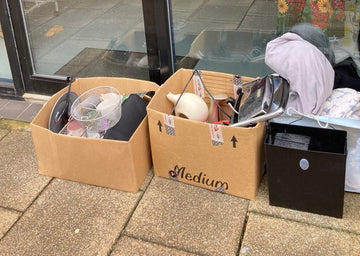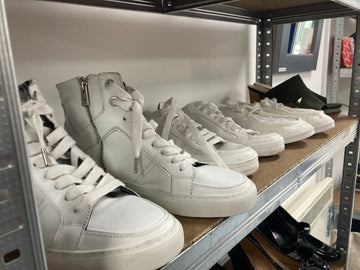Clothing Take-Back Schemes: Garments Destroyed, Burnt, Shredded, Dumped
The clothes you donate as part of clothing take-back schemes could be destroyed, piling up unused in distant warehouses, shredded or even dumped.
A new report from Changing Markets Foundation has revealed that some garment take-back or recycling schemes fail to reuse or recycle the items.
This comes as another shocking indictment against fast fashion and high street brands whose recycling schemes are not rigorous enough to ensure the items they receive actually get put to good use.
Clothing Take-Back Schemes: Do They Actually Work?
What are Clothing Take-Back Schemes?
Clothing take-back schemes are where fashion brands and shops give a discount off brand new clothing when shoppers return their old, unwanted clothing.
There is so much choice when it comes to recycling your old clothes. Lots of high street shops have a box where you can drop off unwanted items.
Online retailers also offer similar take-back schemes, where you can just send off your items in the post.
So, what should happen when you drop your clothes off to be 'recycled'?
Here's what three brands had to say.
H&M say that all items will be "reused, re-worn or recycled with 0% going to landfill".
Zara claim "All clothing collected is given to local organisations that classify the garments depending on their condition and quality. These garments are donated to people at risk of exclusion, sold in second hand stores or are recycled. Proceeds are used to fund social projects by these organisations."
Read More: Where Does Textile Recycling Go, Really?
Primark are partnered with Yellow Octopus, who have a "no landfill policy" with "as many donations as possible to be worn again, with the remainder being repurposed into new products such as insulation, toy stuffing and mattress fillers."
New Investigation Suggests Clothing Take-Back Schemes Are A 'Trick'
Despite the best intentions of various fashion brands, a new study has suggested that many items are destroyed, left in warehouses, exported to Africa, shredded, dumped, even burnt.
Changing Markets Foundation tracked 21 items from 10 fashion brands, using their take-back schemes.
These items were donated or posted to stores in Belgium, France, Germany and the UK and tracked with hidden airtags between August 2022 and July 2023.
Three quarters of these items (16 out of 21) were either "destroyed, left in warehouses or exported to Africa, where up to half of used clothing are quickly shredded for other uses or dumped".
Just five of the donated items were reused in Europe or sold in a resale shop.
Clothing Brands With Recycling Programs: Where the Items End Up
Our latest investigation tracked 21 items dropped off at take-back schemes by @hm @Primark @boohoo @thenorthface @ca_europe @ZARA @UNIQLO_UK @Nike @marksandspencer and found that over 3 quarters are lost, destroyed or shipped to Africa 🗺️ Read more: https://t.co/yO59A6ypr7 pic.twitter.com/RFXjKQOxPS
— Changing Markets Foundation (@ChangingMarkets) July 24, 2023
- H&M: One item resold in Slovakia. One shredded in Czechia. Two in Mali. One in DRC.
- Zara: One item stuck in a warehouse in France. One item never moved, Germany. One item resold in the UK. One item stuck in a warehouse in Lithuania.
- C&A: Two items downcycled. One burned for fuel at cement plant. One shipped to Mauritania (from Belgium).
- Primark: One item dumped in a skip in an industrial estate.
- Nike: One item resold in Ukraine.
- The North Face: One item 'never moved'.
- Uniqlo: One item resold or in second hand shop in Ukraine. One item downcycled in Ukraine.
- M&S: One item destroyed or downcycled in UK.
- New Look: Take-back scheme not operational yet.
- Boohoo: One item resold or in second-hand shop in Belarus.
Are Clothing Take-Back Schemes Greenwashing?
Clothing take-back schemes claim to recycle clothes, but they don't guarantee that these items are recycled or reused.
The Changing Markets report also points out that giving customers a discount for returning old clothes incentivises them to buy more brand new clothing.
It's pretty easy to see how this quickly becomes greenwashing. Offering customers a way to recycle clothes is good, but is it really enough compared to the sheer volume of new clothes being produced?
Read More: 10 Powerful Tools to Help You Spot Greenwashing
Reusing and rewearing clothes is the most sustainable form of fashion. Having to downcycle or recycle clothing takes a lot of energy and resources.
The other issue with recycling or downcycling clothing is that mixed or blended fabrics (e.g polyester blended with cotton) is almost impossible to separate and recycle properly on a large scale.
So some items dropped off in a take-back box are almost always destined to be destroyed.
Interestingly though, all the items that the investigation donated were at least in good used condition, with some of the items even new with tags. In short, these were items that somebody would have been able to wear. And yet some of these were destroyed!
How to Make Clothing Take-Back Schemes Truly Green

Giving people an easy way to recycle their old clothing isn't a bad idea on the whole.
We still need to think about recycling and reusing our clothing where we can.
But it could be improved, especially if it was done on a more local scale.
The key issue is keeping clothes local, i.e within the UK would be getting more people to buy into preloved fashion.
Donating your old used clothes is great. But if you only buy brand new clothing, who is going to be wearing your old clothes? Sure, there are people who cannot afford clothing, which is why it is great to donate quality clothes to charity.
Yet there are still swathes of clothing that far exceed what charity shops can manage. It's partly the reason why clothes are shipped abroad in the first place.
Buying preloved clothes from second hand shops or through online resale websites means that second hand clothing is actually being reused and reworn, rather than shipped abroad to be potentially destroyed. You can be more sure of the item getting a good home.
Brands need to do better, textile recycling companies need to do better, but we, as consumers, can also do better.
Main Photo Credit
clotharrows by Lauren Jong, Flickr. Attribution-NoDerivs 2.0 Generic (CC BY-ND 2.0)




